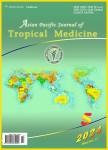Phylogeography,genetic variability and structure of Acanthamoeba metapopulations in Iran inferred by 18S ribosomal RNA sequences:A systematic review and meta-analysis
Phylogeography, genetic variability and structure of Acanthamoeba metapopulations in Iran inferred by 18S ribosomal RNA sequences: A systematic review and meta-analysis作者机构:Immunology Research CenterTabriz University of Medical SciencesTabrizIran Department of Parasitology and MycologyFaculty of MedicineTabriz University of Medical SciencesTabrizIran Department of Medical Parasitology and MycologySchool of MedicineShahid Beheshti University of Medical SciencesTehranIran Department of Parasitology and MycologySchool of MedicineIsfahan University of Medical SciencesIsfahanIran
出 版 物:《Asian Pacific Journal of Tropical Medicine》 (亚太热带医药杂志(英文版))
年 卷 期:2017年第10卷第9期
页 面:855-863页
核心收录:
学科分类:1001[医学-基础医学(可授医学、理学学位)] 100103[医学-病原生物学] 10[医学]
基 金:financially supported by Immunology Research Center Tabriz University of Medical Sciences Tabriz Iran
主 题:Acanthamoeba metapopulations Genetic variability Gene flow Molecular phylogeny Iran
摘 要:Objective: To verify phylogeography and genetic structure of Acanthamoeba populations among the Iranian clinical isolates and natural/artificial environments distributed in various regions of the ***: We searched electronic databases including Medline, Pub Med, Science Direct, Scopus and Google Scholar from 2005 to 2016. To explore the genetic variability of Acanthamoeba sp, 205 sequences were retrieved from keratitis patients, immunosuppressed cases and environmental sources as of various geographies of ***: T4 genotype was the predominant strain in Iran, and the rare genotypes belonged to T2, T3, T5(Acanthamoeba lenticulata), T6, T9, T11, T13 and T15(Acanthamoeba jacobsi).A total of 47 unique haplotypes of T4 were identified. A parsimonious network of the sequence haplotypes demonstrated star-like feature containing haplogroups IR6(34.1%) and IR7(31.2%) as the most common haplotypes. In accordance with the analysis of molecular variance, the high value of haplotype diversity(0.612–0.848) of Acanthamoeba T4 represented genetic variability within populations. Neutrality indices of the 18 S ribosomal RNA demonstrated negative values in all populations which represented a considerable divergence from neutrality. The majority of genetic diversity belonged to the infected contact lens and dust samples in immunodeficiency and ophthalmology wards, which indicated potential routes for exposure to a pathogenic Acanthamoeba sp. in at-risk individuals. A pairwise fixation index(FST) was from low to high values(0.024 33–0.418 92). The statistically FST points out that T4 is genetically differentiated between north-west, north-south and centralsouth metapopulations, but not differentiated between west-central, west-south, centralsouth, and north-central ***: An occurrence of IR6 and IR7 displays that possibly a gene flow of Acanthamoeba T4 occurred after the founder effect or bottleneck experience through ecological changes or host mobility



